
How to Use SX1278 RA-02: Examples, Pinouts, and Specs
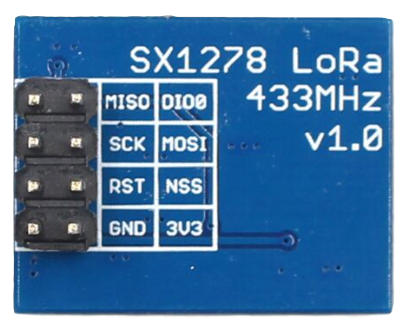
 Design with SX1278 RA-02 in Cirkit Designer
Design with SX1278 RA-02 in Cirkit DesignerIntroduction
The SX1278 RA-02 is a low-power, long-range transceiver module designed for wireless communication. It operates in the sub-GHz frequency range (typically 433 MHz or 868 MHz) and supports LoRa (Long Range) modulation technology. LoRa enables robust, long-distance communication with low power consumption, making the SX1278 RA-02 ideal for Internet of Things (IoT) applications.
Explore Projects Built with SX1278 RA-02
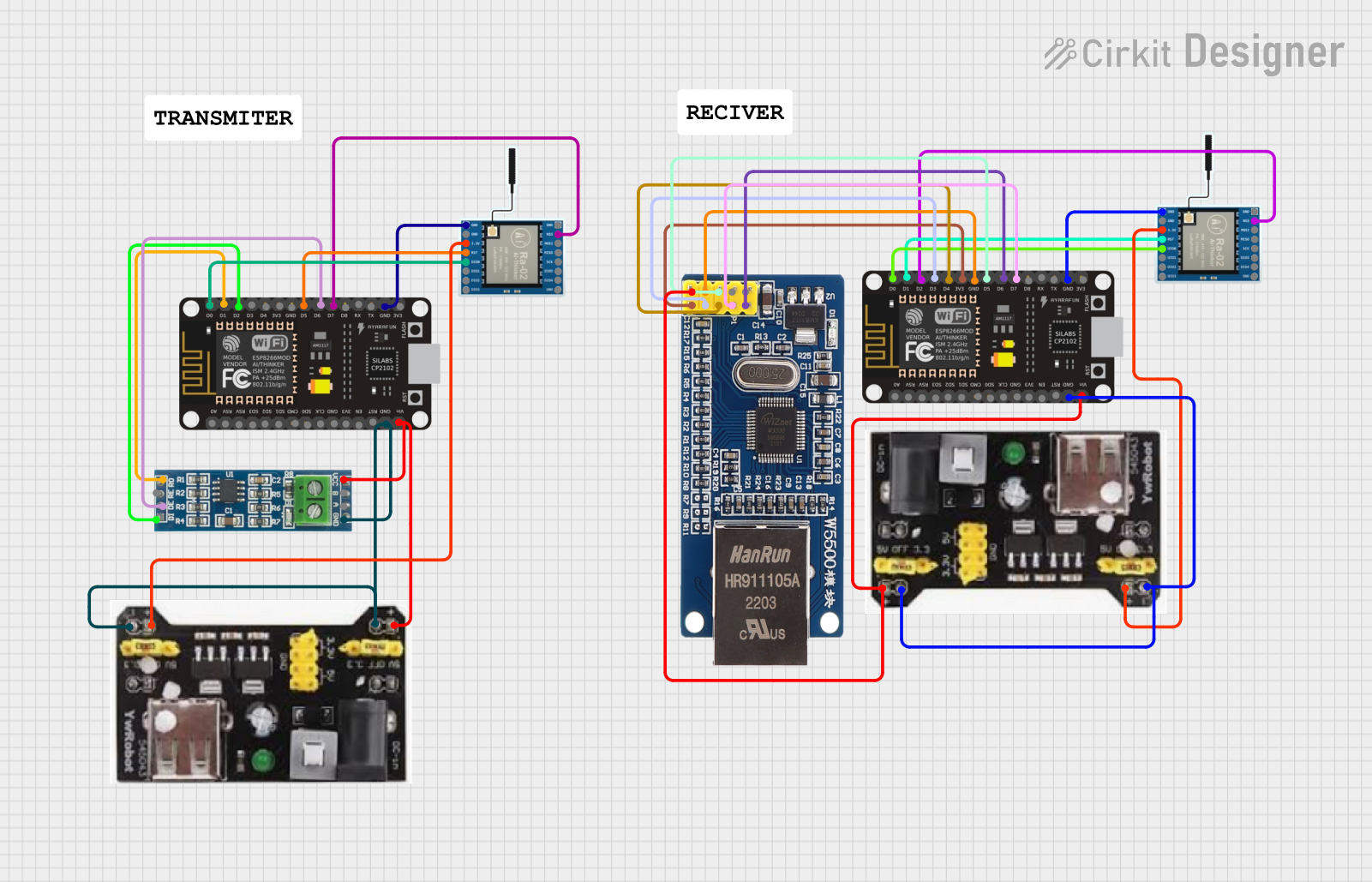
 Open Project in Cirkit Designer
Open Project in Cirkit Designer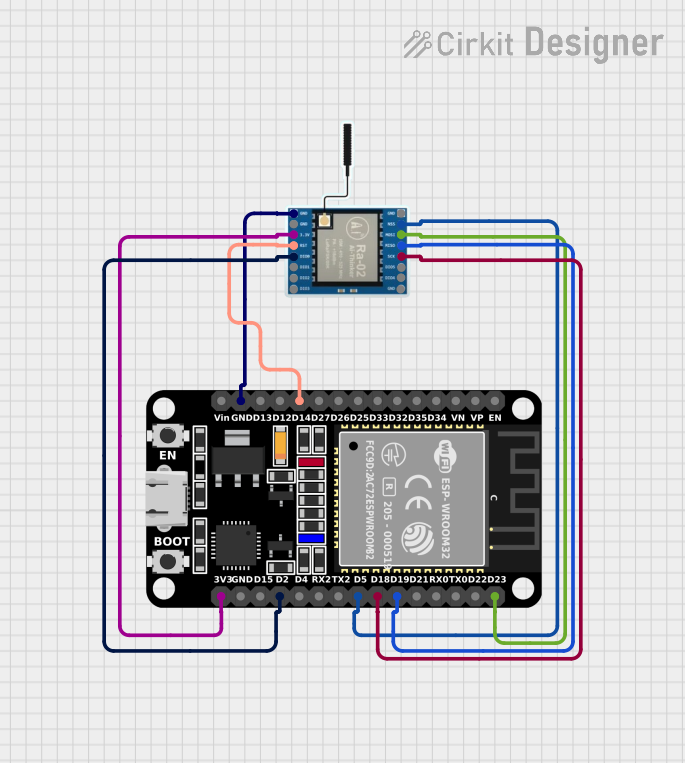
 Open Project in Cirkit Designer
Open Project in Cirkit Designer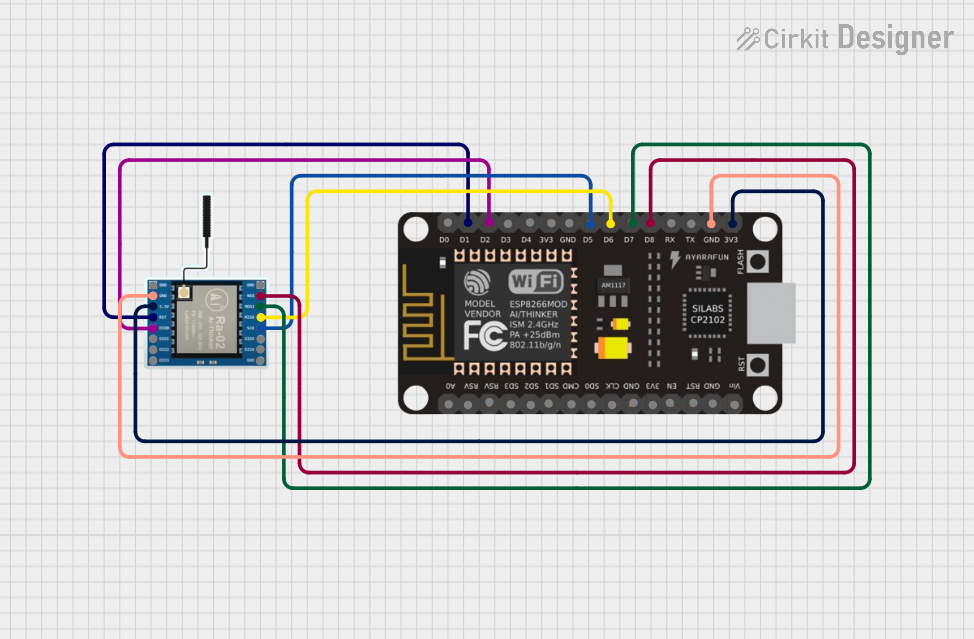
 Open Project in Cirkit Designer
Open Project in Cirkit Designer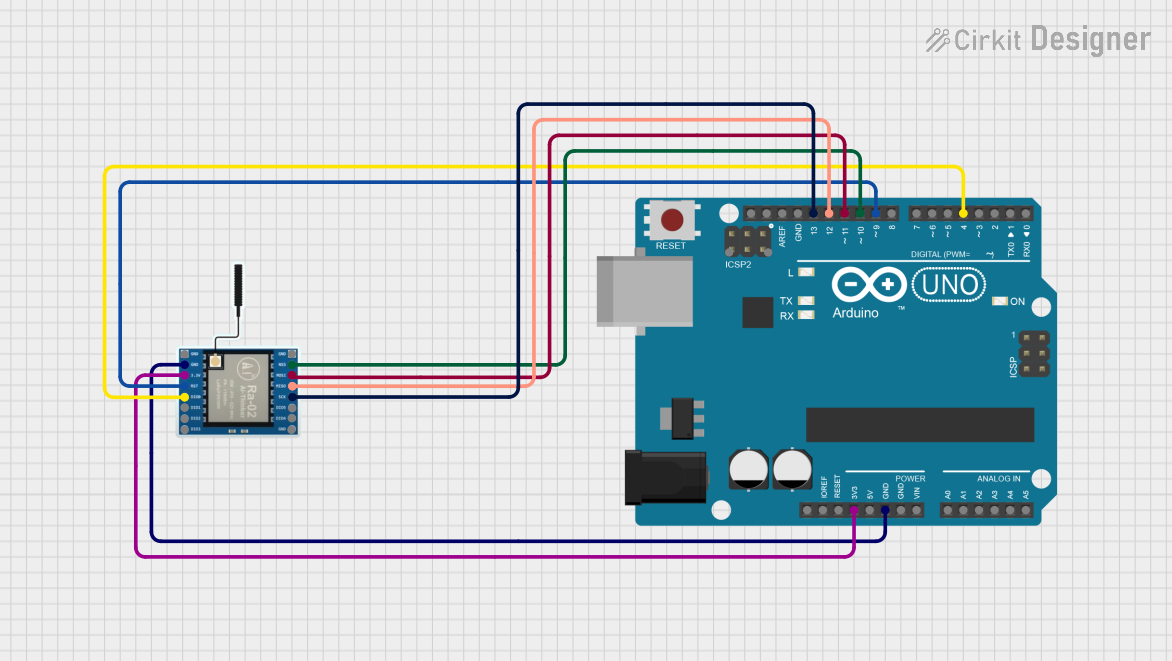
 Open Project in Cirkit Designer
Open Project in Cirkit DesignerExplore Projects Built with SX1278 RA-02

 Open Project in Cirkit Designer
Open Project in Cirkit Designer
 Open Project in Cirkit Designer
Open Project in Cirkit Designer
 Open Project in Cirkit Designer
Open Project in Cirkit Designer
 Open Project in Cirkit Designer
Open Project in Cirkit DesignerCommon Applications and Use Cases
- Smart agriculture (e.g., soil moisture monitoring, weather stations)
- Industrial automation and control systems
- Smart cities (e.g., parking sensors, street lighting control)
- Home automation and security systems
- Remote data logging and telemetry
- Wireless sensor networks
Technical Specifications
The SX1278 RA-02 module is designed to provide reliable and efficient wireless communication. Below are its key technical specifications:
| Parameter | Value |
|---|---|
| Frequency Range | 433 MHz / 868 MHz (configurable) |
| Modulation | LoRa, FSK, GFSK |
| Sensitivity | -148 dBm (LoRa mode) |
| Output Power | Up to +20 dBm |
| Data Rate | 0.018 kbps to 37.5 kbps (LoRa) |
| Supply Voltage | 1.8V to 3.7V |
| Current Consumption | 10.8 mA (Rx mode), 120 mA (Tx mode) |
| Communication Interface | SPI |
| Operating Temperature | -40°C to +85°C |
| Dimensions | 17.8 mm x 16.5 mm x 2.3 mm |
Pin Configuration and Descriptions
The SX1278 RA-02 module has 16 pins. Below is the pinout and description:
| Pin Number | Pin Name | Description |
|---|---|---|
| 1 | GND | Ground connection |
| 2 | DIO5 | Digital I/O pin 5 |
| 3 | DIO4 | Digital I/O pin 4 |
| 4 | DIO3 | Digital I/O pin 3 |
| 5 | DIO2 | Digital I/O pin 2 |
| 6 | DIO1 | Digital I/O pin 1 |
| 7 | DIO0 | Digital I/O pin 0 (used for interrupts) |
| 8 | NSS | SPI chip select (active low) |
| 9 | MISO | SPI Master-In-Slave-Out |
| 10 | MOSI | SPI Master-Out-Slave-In |
| 11 | SCK | SPI clock |
| 12 | RESET | Reset pin (active low) |
| 13 | 3.3V | Power supply input (3.3V recommended) |
| 14 | ANT | Antenna connection |
| 15 | GND | Ground connection |
| 16 | GND | Ground connection |
Usage Instructions
How to Use the SX1278 RA-02 in a Circuit
- Power Supply: Connect the
3.3Vpin to a regulated 3.3V power source. Ensure the ground (GND) pins are connected to the circuit's ground. - Antenna: Attach a suitable antenna to the
ANTpin for optimal signal transmission and reception. - SPI Communication: Connect the SPI pins (
NSS,MISO,MOSI,SCK) to the corresponding SPI pins of your microcontroller. - Interrupts: Use the
DIOpins for handling interrupts or additional control signals as required by your application. - Reset: Connect the
RESETpin to a GPIO pin on your microcontroller or a manual reset button.
Important Considerations and Best Practices
- Antenna Design: Use a high-quality antenna and ensure proper impedance matching for maximum range and performance.
- Power Supply: Use a stable and noise-free 3.3V power supply to avoid communication issues.
- SPI Configuration: Configure the SPI interface on your microcontroller to match the SX1278's requirements (e.g., clock polarity and phase).
- LoRa Parameters: Adjust LoRa parameters (e.g., spreading factor, bandwidth, coding rate) to balance range, data rate, and power consumption.
- Regulatory Compliance: Ensure the operating frequency and transmission power comply with local regulations.
Example Code for Arduino UNO
Below is an example of how to use the SX1278 RA-02 with an Arduino UNO. This code uses the popular LoRa library.
#include <SPI.h>
#include <LoRa.h>
// Define LoRa module pins
#define NSS 10 // SPI chip select
#define RESET 9 // Reset pin
#define DIO0 2 // DIO0 pin for interrupts
void setup() {
Serial.begin(9600); // Initialize serial communication
while (!Serial);
Serial.println("Initializing LoRa module...");
// Initialize LoRa module
LoRa.setPins(NSS, RESET, DIO0);
if (!LoRa.begin(433E6)) { // Set frequency to 433 MHz
Serial.println("LoRa initialization failed!");
while (1);
}
Serial.println("LoRa initialized successfully!");
}
void loop() {
Serial.println("Sending packet...");
// Send a test message
LoRa.beginPacket();
LoRa.print("Hello, LoRa!");
LoRa.endPacket();
delay(5000); // Wait 5 seconds before sending the next packet
}
Notes:
- Install the
LoRalibrary in the Arduino IDE before uploading the code. - Modify the frequency (
433E6or868E6) based on your module's configuration and local regulations.
Troubleshooting and FAQs
Common Issues and Solutions
No Communication with the Module
- Solution: Verify the SPI connections and ensure the correct pin assignments in your code.
- Tip: Check the power supply voltage and ensure it is stable at 3.3V.
Poor Signal Range
- Solution: Use a high-quality antenna and ensure it is properly connected to the
ANTpin. - Tip: Avoid placing the module near metal objects or other sources of interference.
- Solution: Use a high-quality antenna and ensure it is properly connected to the
LoRa Initialization Fails
- Solution: Ensure the
NSS,RESET, andDIO0pins are correctly connected and configured in the code. - Tip: Double-check the operating frequency and ensure it matches the module's configuration.
- Solution: Ensure the
High Power Consumption
- Solution: Use low-power modes when the module is idle. Adjust the transmission power settings if possible.
- Tip: Optimize LoRa parameters to reduce power usage without compromising performance.
FAQs
Can the SX1278 RA-02 operate at 5V?
- No, the module operates at 3.3V. Using 5V may damage the module.
What is the maximum range of the SX1278 RA-02?
- The range depends on factors like antenna quality, environment, and LoRa parameters. In open areas, it can reach up to 10 km.
Can I use the SX1278 RA-02 with other microcontrollers?
- Yes, the module can be used with any microcontroller that supports SPI communication.
How do I change the operating frequency?
- The frequency can be set in the code using the
LoRa.begin()function. Ensure the selected frequency complies with local regulations.
- The frequency can be set in the code using the